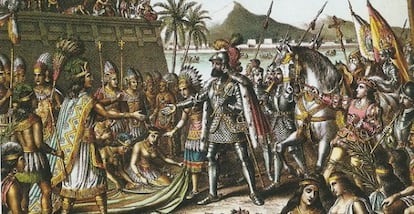Dig at Mexican ruins reveals the ritual sacrifice of a Spanish expedition
At least 550 people were decapitated and eaten by Indians during Cortés’ Aztec conquest


A recent dig at a pre-Hispanic site outside Mexico City has uncovered new revelations about the fate of 550 people who accompanied Spanish explorer Hernán Cortés during his 16th-century conquest of Mexico.
Archeologists at the Zultépec-Tecoaque site – located about 63 kilometers from Mexico City – believe a caravan organized by Cortés was attacked by Acolhua Indians as it tried to reach the Aztec capital of Tenochtitlán. The Acolhuas were allied to the Aztecs.
The men, women and children were sacrificed one by one to the Acolhuas’ ancient gods
Captured and taken to tribal leaders, the men, women and children were led down to a tunnel where there was no escape, and one by one they were sacrificed to the Acolhuas’ ancient gods.
The long ordeal reportedly took place between June 1520 and March 1521.
When Cortés’ men arrived at Zultépec to search for their companions, they learned about the mass killings and destroyed the entire town.
Excavations at the site were restarted in August after the first digs were carried out between 1993 and 2010. In their latest discoveries, archeologists found cells where the Spanish prisoners spent their last days.
“What occurred then was a clash of cultures, but at the same time there was a lot of resistance,” explained Enrique Martínez Vázquez, from the National Institute for Anthropology and History (INAH), and who is in charge of the excavations.
Hernán Cortés partly described the slaughter in his Cartas de relación (Related letters) in which he recalled an expedition led by Pánfilo Narváez, who was sent by the governor of Cuba to arrest the Spanish conquistador.
When Cortés learned of Narváez’s arrival, he left Tenochtitlán and traveled east to confront his would-be captor, finally defeating him at Cempoala on May 24, 1520.
But his victory was short-lived.
Following the slaughters carried out by Pedro de Alvarado in Tenochtitlán, Spain’s control over the Aztecs was wavering and Cortés decided to return to the capital.
But before his journey, he organized an expedition to take the injured, sick, women and provisions to Tenochtitlán. According to Martínez Vargas, five Spaniards rode on horseback while 45 men marched on foot.
What occurred then was a clash of cultures”
Enrique Martínez Vázquez
Accompanying them was a contingent of Afro-Caribbeans, Taino Indians and mulattoes who had all come from Cuba. Also with them were about 350 Mesoamerican Indians, who sided with the Spanish, and about 50 women and 10 children.
The Acolhuas captured them all before they could reach the Aztec capital.
By June 1520, the Aztec rebellion was in full swing.
The Zultépec excavations reveal how some Indian dwellings had been used to house the prisoners while other structures were specifically built for imprisoning the captured. Ancient statues and figurines have also been found.
The prisoners were sacrificed in the name of the Aztec gods: Huitzilopochtli, god of war; Tezcatlipoca, god of heaven and earth; and Quetzalcóatl, the serpent god.
Among the remains found at Zultépec are skulls of Europeans and Mesoamericans.
The Zultépec excavations reveal how some Indian dwellings had been used to house the prisoners
The Spanish priests who accompanied Cortés on his conquest described how prisoners captured by the Aztecs on some occasions were forced to dance during a ritual before they were later decapitated and dismembered. The Indians usually feasted on their remains.
In honor of Huitzilopochtli, the hearts were ripped from their bodies before they were thrown off the long stairs of a temple.
At Zultépec, the heads of the victims were placed on display on an altar.
When Captain Gonzalo de Sandoval arrived at Zultépec with 15 horsemen and 200 soldiers, he found that the entire caravan was gone. On a wall he read where someone wrote in charcoal: “Here the unlucky Juan Yuste was held prisoner.”
The Spanish showed no pity for the Acolhuas – the entire town was razed. Later, the site was renamed Tecoaque or “the place where the people were eaten.”
Tenochtitlán fell to the Spanish on August 13, 1521.
English version by Martin Delfín.
Tu suscripción se está usando en otro dispositivo
¿Quieres añadir otro usuario a tu suscripción?
Si continúas leyendo en este dispositivo, no se podrá leer en el otro.
FlechaTu suscripción se está usando en otro dispositivo y solo puedes acceder a EL PAÍS desde un dispositivo a la vez.
Si quieres compartir tu cuenta, cambia tu suscripción a la modalidad Premium, así podrás añadir otro usuario. Cada uno accederá con su propia cuenta de email, lo que os permitirá personalizar vuestra experiencia en EL PAÍS.
¿Tienes una suscripción de empresa? Accede aquí para contratar más cuentas.
En el caso de no saber quién está usando tu cuenta, te recomendamos cambiar tu contraseña aquí.
Si decides continuar compartiendo tu cuenta, este mensaje se mostrará en tu dispositivo y en el de la otra persona que está usando tu cuenta de forma indefinida, afectando a tu experiencia de lectura. Puedes consultar aquí los términos y condiciones de la suscripción digital.
Últimas noticias
Pinochet’s victims grapple with José Antonio Kast’s rise in Chile
Reinhard Genzel, Nobel laureate in physics: ‘One-minute videos will never give you the truth’
How Japan is trying to avert ‘digital defeat’
The complicated life of Francesca Albanese: A rising figure in Italy but barred from every bank by Trump’s sanctions
Most viewed
- Pablo Escobar’s hippos: A serious environmental problem, 40 years on
- Why we lost the habit of sleeping in two segments and how that changed our sense of time
- Trump’s obsession with putting his name on everything is unprecedented in the United States
- Charles Dubouloz, mountaineering star, retires at 36 with a farewell tour inspired by Walter Bonatti
- The Florida Keys tourist paradise is besieged by immigration agents: ‘We’ve never seen anything like this’








































